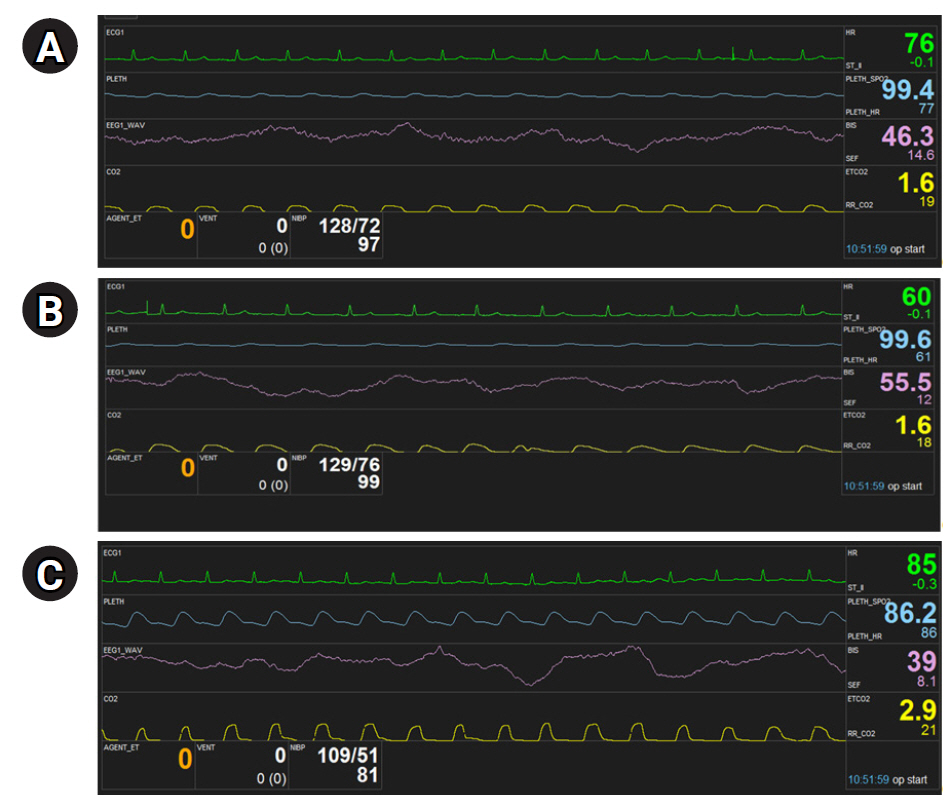Anesth Pain Med.
2020 Oct;15(4):505-509. 10.17085/apm.20043.
A novel application of Transnasal Humidified Rapid Insufflation Ventilatory Exchange via the oral route in morbidly obese patient during monitored anesthesia care - A case report -
- Affiliations
-
- 1Department of Anesthesiology and Pain Medicine, Soonchunhyang University Bucheon Hospital, Soonchunhyang University College of Medicine, Bucheon, Korea
- KMID: 2508415
- DOI: http://doi.org/10.17085/apm.20043
Abstract
- Background
Transnasal Humidified Rapid Insufflation Ventilatory Exchange (THRIVE) is used to improve oxygenation, with the added benefit of a smaller increase in CO2 if self-respiration is maintained with THRIVE. Despite these advantages, the use of THRIVE through a nasal cannula is limited in situations such as epistaxis or a basal skull fracture. Case We successful used THRIVE, through the oral route under general anesthesia with spontaneous breathing in a morbidly obese patient (weight, 148 kg; height, 183 cm; body mass index, 44.2 kg/m2) who received transnasal steroid injections due to subglottic stenosis.
Conclusions
THRIVE through the oral route may be an effective novel option, although further studies are needed.
Figure
Reference
-
1. Bouroche G, Bourgain JL. Preoxygenation and general anesthesia: a review. Minerva Anestesiol. 2015; 81:910–20.2. Huang L, Dharmawardana N, Badenoch A, Ooi EH. A review of the use of transnasal humidified rapid insufflation ventilatory exchange for patients undergoing surgery in the shared airway setting. J Anesth. 2020; 34:134–43.3. Yang SH, Wu CY, Tseng WH, Cherng WY, Hsiao TY, Cheng YJ, et al. Nonintubated laryngomicrosurgery with transnasal humidified rapid-insufflation ventilatory exchange: a case series. J Formos Med Assoc. 2019; 118:1138–43.4. To K, Harding F, Scott M, Milligan P, Nixon IJ, Adamson R, et al. The use of transnasal humidified rapid-insufflation ventilatory exchange in 17 cases of subglottic stenosis. Clin Otolaryngol. 2017; 42:1407–10.5. Maupeu L, Raguin T, Hengen M, Diemunsch P, Schultz P. Indications of transnasal humidified rapid-insufflation ventilatory exchange (THRIVE) in laryngoscopy, a prospective study of 19 cases. Clin Otolaryngol. 2019; 44:182–6.6. Rittayamai N, Tscheikuna J, Rujiwit P. High-flow nasal cannula versus conventional oxygen therapy after endotracheal extubation: a randomized crossover physiologic study. Respir Care. 2014; 59:485–90.7. Lee SJ, Quek KH. Facilitating airway surgery in a morbidly obese patient using transnasal humidified rapid insufflation ventilatory exchange (THRIVE). Case Rep Anesthesiol. 2018; 2018:5310342.8. Renda T, Corrado A, Iskandar G, Pelaia G, Abdalla K, Navalesi P. High-flow nasal oxygen therapy in intensive care and anaesthesia. Br J Anaesth. 2018; 120:18–27.9. Bertelsen C, Shoffel-Havakuk H, O'Dell K, Johns MM 3rd, Reder LS. Serial in-office intralesional steroid injections in airway stenosis. JAMA Otolaryngol Head Neck Surg. 2018; 144:203–10.10. Heard A, Toner AJ, Evans JR, Aranda Palacios AM, Lauer S. Apneic oxygenation during prolonged laryngoscopy in obese patients: a randomized, controlled trial of buccal RAE tube oxygen administration. Anesth Analg. 2017; 124:1162–7.11. Achar SK, Pai AJ, Shenoy UK. Apneic oxygenation during simulated prolonged difficult laryngoscopy: comparison of nasal prongs versus nasopharyngeal catheter: a prospective randomized controlled study. Anesth Essays Res. 2014; 8:63–7.12. Toner AJ, Douglas SG, Bailey MA, Avis HJ, Pillai AV, Phillips M, et al. Effect of apneic oxygenation on tracheal oxygen levels, tracheal pressure, and carbon dioxide accumulation: a randomized, controlled trial of buccal oxygen administration. Anesth Analg. 2019; 128:1154–9.13. Booth AWG, Vidhani K, Lee PK, Thomsett CM. Spontaneous respiration using intravenous anaesthesia and Hi-flow nasal oxygen (STRIVE Hi) maintains oxygenation and airway patency during management of the obstructed airway: an observational study. Br J Anaesth. 2017; 118:444–51.14. Gustafsson IM, Lodenius Å, Tunelli J, Ullman J, Jonsson Fagerlund M. Apnoeic oxygenation in adults under general anaesthesia using transnasal humidified rapid-insufflation ventilatory exchange (THRIVE) - a physiological study. Br J Anaesth. 2017; 118:610–7.15. Hermez LA, Spence CJ, Payton MJ, Nouraei SAR, Patel A, Barnes TH. A physiological study to determine the mechanism of carbon dioxide clearance during apnoea when using transnasal humidified rapid insufflation ventilatory exchange (THRIVE). Anaesthesia. 2019; 74:441–9.
- Full Text Links
- Actions
-
Cited
- CITED
-
- Close
- Share
- Similar articles
-
- Anesthetic Management of a Morbidly Obese Parturient for Cesarean Section
- Oral surgery under local anesthesia with dexmedetomidine sedation in a morbidly obese patient with aortic dissection
- Totally robotic Roux-en-Y gastric bypass in a morbidly obese patient in Korea: a case report
- Cardiovascular and Ventilatory Changes during Laparoscopic Cholecystectomy under General Anesthesia
- Fatal Rhabdomyolysis following Spine Surgery in a Morbidly Obese Patient: A Case Report



